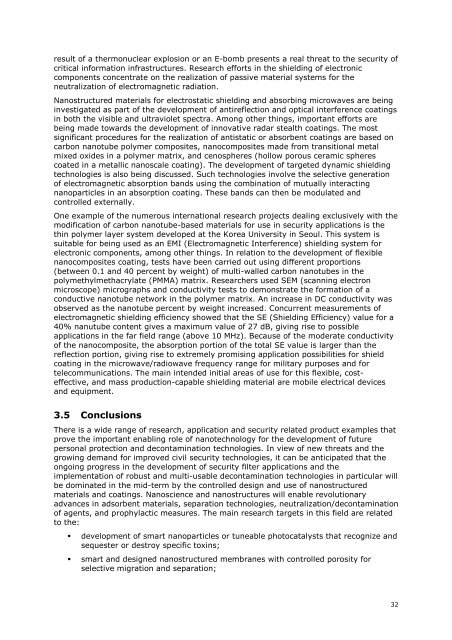Download - Nanowerk
Download - Nanowerk
Download - Nanowerk
You also want an ePaper? Increase the reach of your titles
YUMPU automatically turns print PDFs into web optimized ePapers that Google loves.
esult of a thermonuclear explosion or an E-bomb presents a real threat to the security of<br />
critical information infrastructures. Research efforts in the shielding of electronic<br />
components concentrate on the realization of passive material systems for the<br />
neutralization of electromagnetic radiation.<br />
Nanostructured materials for electrostatic shielding and absorbing microwaves are being<br />
investigated as part of the development of antireflection and optical interference coatings<br />
in both the visible and ultraviolet spectra. Among other things, important efforts are<br />
being made towards the development of innovative radar stealth coatings. The most<br />
significant procedures for the realization of antistatic or absorbent coatings are based on<br />
carbon nanotube polymer composites, nanocomposites made from transitional metal<br />
mixed oxides in a polymer matrix, and cenospheres (hollow porous ceramic spheres<br />
coated in a metallic nanoscale coating). The development of targeted dynamic shielding<br />
technologies is also being discussed. Such technologies involve the selective generation<br />
of electromagnetic absorption bands using the combination of mutually interacting<br />
nanoparticles in an absorption coating. These bands can then be modulated and<br />
controlled externally.<br />
One example of the numerous international research projects dealing exclusively with the<br />
modification of carbon nanotube-based materials for use in security applications is the<br />
thin polymer layer system developed at the Korea University in Seoul. This system is<br />
suitable for being used as an EMI (Electromagnetic Interference) shielding system for<br />
electronic components, among other things. In relation to the development of flexible<br />
nanocomposites coating, tests have been carried out using different proportions<br />
(between 0.1 and 40 percent by weight) of multi-walled carbon nanotubes in the<br />
polymethylmethacrylate (PMMA) matrix. Researchers used SEM (scanning electron<br />
microscope) micrographs and conductivity tests to demonstrate the formation of a<br />
conductive nanotube network in the polymer matrix. An increase in DC conductivity was<br />
observed as the nanotube percent by weight increased. Concurrent measurements of<br />
electromagnetic shielding efficiency showed that the SE (Shielding Efficiency) value for a<br />
40% nanutube content gives a maximum value of 27 dB, giving rise to possible<br />
applications in the far field range (above 10 MHz). Because of the moderate conductivity<br />
of the nanocomposite, the absorption portion of the total SE value is larger than the<br />
reflection portion, giving rise to extremely promising application possibilities for shield<br />
coating in the microwave/radiowave frequency range for military purposes and for<br />
telecommunications. The main intended initial areas of use for this flexible, costeffective,<br />
and mass production-capable shielding material are mobile electrical devices<br />
and equipment.<br />
3.5 Conclusions<br />
There is a wide range of research, application and security related product examples that<br />
prove the important enabling role of nanotechnology for the development of future<br />
personal protection and decontamination technologies. In view of new threats and the<br />
growing demand for improved civil security technologies, it can be anticipated that the<br />
ongoing progress in the development of security filter applications and the<br />
implementation of robust and multi-usable decontamination technologies in particular will<br />
be dominated in the mid-term by the controlled design and use of nanostructured<br />
materials and coatings. Nanoscience and nanostructures will enable revolutionary<br />
advances in adsorbent materials, separation technologies, neutralization/decontamination<br />
of agents, and prophylactic measures. The main research targets in this field are related<br />
to the:<br />
development of smart nanoparticles or tuneable photocatalysts that recognize and<br />
sequester or destroy specific toxins;<br />
smart and designed nanostructured membranes with controlled porosity for<br />
selective migration and separation;<br />
32

















